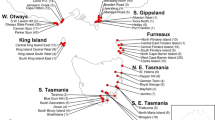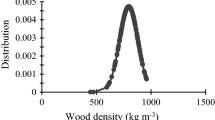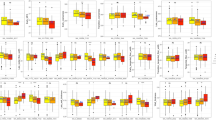Abstract
An association genetics approach was used to examine individual genes and alleles at several loci responsible for complex traits controlling wood traits (cellulose, lignin, and 6C sugar) in European black poplar (Populus nigra). Due to fast growth, clonal propagation and availability of genomic resources have allowed us to investigate further genetic control of wood traits in the species. From thirty-nine candidate genes, 384 SNPs were successfully genotyped in a clonally replicated 288 P. nigra clone population. Only 50.5% of these markers were polymorphic that could be used in association mappings.
The association population (4 ramets per clone) was phenotyped for cellulose, lignin, and 6C sugar contents. Moderately high heritabilities were observed for cellulose and 6C sugar while it was low in lignin. Furthermore, a moderately strong and positive genetic correlation was found between cellulose and lignin which may hinder genetic improvement in cellulose content due to the correlated response on lignin. The LD, across all candidate genes, showed a rapid decay with physical distance. Single-marker-based association tests using GLM and MLM models were implemented to identify associations for cellulose, lignin, and 6C sugar contents.
Eleven unique single marker associations for cellulose, 5 for lignin, and 6C sugar contents were identified from 39 candidate genes, but only one marker for cellulose content (CesA3A-15-456) had a significant association with cellulose and with dominant gene effect after multiple test correction was applied. The percent of total variation explained by significant single marker associations ranged from 3 to 9.2% in cellulose, 2.8 to 3.8% in lignin, and 3.2–5.5% in 6C sugar contents, respectively. Given the rapid decay of within-gene linkage disequilibrium, limitation of sample size, overcorrection for false positives, and intensity of phenotypic selection, it is likely that some of these single marker associations are genuine and deserve to be further investigated with a larger and diverse study population.








Similar content being viewed by others
Data availability
Datasets which were not already publicly available at the time of submission will be deposited to The Species database of Tree Genes database (http://treegenesdb.org) upon the acceptance of the paper.
References
Allwright MR, Taylor G (2016) Molecular breeding for improved second generation bioenergy crops. Trends Plant Sci 21(1):43–54
Beaulieu J, Doerksen T, Boyle B, Clement S, Deslauriers M, Beauseigle S, Blais S, Poulin P-L, Lenz P, Caron S et al (2011) Association genetics of wood physical traits in the conifer white spruce and relationships with gene expression. Genetics 188:197–214
Bradbury PJ, Zhang Z, Kroon DE, Casstevens TM, Ramdoss Y, Buckler ES (2007) TASSEL: software for association mapping of complex traits in diverse samples. Bioinformatics 23:2633–2635
Brenner AM, Busov VB, Strauss SH (2004) Poplar genome sequence: functional genomics in an ecologically dominant plant species. Trends Plant Sci 9:49–56
Ciftci A, Kaya Z (2019) Genetic diversity and structure of Populus nigra populations in two highly fragmented river ecosystems from Turkey. Tree Genet Genomes 15:66
Ciftci A, Yelmen B, Degirmenci FÖ, Kaya Z (2020) Impact of biased sex ratio on genetic diversity, structure and differentiation of Populus nigra populations. Botany 98(10):603–613
Ciftci A, Karatay H, Küçükosmanoğlu F, Karahan A, Kaya Z (2017) Genetic differentiation between clone collections and natural populations of European black poplar (Populus nigra L.) in Turkey. Tree Genet Genomes 13:69
Cumbie WP, Eckert A, Wegrzyn J, Whetten R, Neale D, Goldfarb B (2011) Association genetics of carbon isotope discrimination, height and foliar nitrogen in a natural population of Pinus taeda L. Heredity 107:105–114
Davis JM, Vermerris W (2008) Genetic Improvement of bioenergy crops genetic improvement of poplar (Populus spp.) as a bioenergy crop. Springer New York, New York, pp 397-419
Davison HB, Drescher SR, Tuskan GA, Davis MF, Ngheim NP (2006) Variation of S/G ratio and lignin content in a populus family influences the release of xylose by dilute acid hydrolysis. Appl Biochem Biotechnol 130(1-3):427–435. https://doi.org/10.1385/abab:130:1:427
Dence C (1992) The determination of lignin. In: Lin S, Dence C (eds) Methods in lignin chemistry. Springer-Verlag, Berlin, pp 33–62
Dillon S, Nolan M, Wu H, Southerton S (2010) Association genetics reveal candidate gene SNPs affecting wood properties in Pinus radiata. Aust For 73:185–190
Eckert AJ, Bower AD, Wegrzyn JL, Pande B, Jermstad KD, Krutovsky KV, Clair JBS, Neale DB (2009) Asssociation genetics of coastal douglas fir (Pseudotsuga menziesii var. menziesii, Pinaceae). I Cold-hardiness related traits. Genetics 182:1289–1302
Eckert AJ, Wegrzyn JL, Cumbie WP, Goldfarb B, Huber DA, Tolstikov V, Fiehn O, Neale DB (2012) Association genetics of the loblolly pine (Pinus taeda, Pinaceae) metabolome. New Phytol 193:890–902
EUFORGEN (2015) Distribution map of black poplar (Populus nigra), www.euforgen.org. First published online in 2004- updated on 13 January 2015. Accessed 31 May 2019
Evanno G, Regnaut S, Goudet J (2005) Detecting the number of clusters of individuals using the software STRUCTURE: a simulation study. Mol Ecol 14:2611–2620
Faivre-Rampant P, Zaina G, Jorge V, Giacomello S, Segura V, Scalabrin S, Guérin V, De Paoli E, Aluome C, Viger M, Cattonaro F, Payne A, Paul Stephen Raj P, Le Paslier MC, Berard A, Allwright MR, Villar M, Taylor G, Bastien C, Morgante M (2016) New resources for genetic studies in Populus nigra : genome-wide SNP discovery and development of a 12k Infinium array. Mol Ecol Resour 16(4):1023–1036
Falush D, Stephens M, Pritchard JK (2003) Inference of population structure using multilocus genotype data: linked loci and correlated allele frequencies. Genetics 164:1567–1587
Fan J, Oliphant A, Shen R, Kermani B, Garcia F, Gunderson K, Hansen M, Steemers F, Butler S, Deloukas P et al (2003) Highly parallel SNP genotyping. Cold Spring Harb Symp Quant Biol 68:69–78
Field A, Miles M, Field Z (2012) Discovering statistics using R. SAGE Publications Ltd, London, p 935
Gonzalez-Martinez SC, Wheeler NC, Ersoz E, Nelson CD, Neale DB (2007) Association genetics in Pinus taeda L. I. Wood property traits. Genetics 175:399–409
Groover AT, Nieminen K, Helariutta Y, Mansfield SD, Jansson S, Bhalerao R, Groover A (2010) Genetics and genomics of populus wood formation in Populus. Springer New York, New York, pp 201–224
Guerra FP, Wegrzyn JL, Sykes R, Davis MF, Stanton BJ, Neale DB (2013) Association genetics of chemical wood properties in black poplar (Populus nigra). New Phytol 197:162–176
Hedge JE, Hofreiter BT (1962) In: Whistler RL, Miller JNB (eds) Carbohydrate chemistry 17. Academic Press, New York
Kaya Z, Steel F, Temerit A, Vurdu H (2003) Genetic variation in wood specific gravity of aalf-sib families of Pinus nigra subsp. pallasiana tested at the juvenile stage: Implications for early selection. Silvae Genetica 52(3-4):153–158
Kaya Z, Neale DB, Semerci A, Karahan A, Kahraman T, Kahraman FK, Karatay H (2014) Genetic characterization of Turkish Black poplar genetic resources and development of molecular black poplar breeding program. The Scientific and Technical Research Council of Turkey, Agriculture, Forestry and Veterinary Research Grant Committee, Project Final Report (TOVAG110O570), 80.
Lewin M, Goldstein IS (1991) Wood structure and composition. Markel Dekker, New York
Lewis PO, Zaykin D (2001) GDA (Genetic Data Analysis): Computer program for the analysis of allelic data, version 1.1. University of Connecticut, Storrs. http://phylogeny.uconn.edu/software. Last accessed 1 Nov 2022
Neale DB, Wheeler NC (2019) Conifers: genomes, variation and evolution 1st ed. Springer Nature Switzerland AG 2019, Cham, Switzerland, p 590
Neale DB, Kremer A (2011) Forest tree genomics: growing resources and applications. Nat Rev Genet 12:111–122
Neale DB, Savolainen O (2004) Association genetics of complex traits in conifers. Trends Plant Sci 9:325–330
Patterson N, Price A, Reich D (2006) Population structure and eigen analysis. PLoS Genetica 2:2074–2093
Pégard M, Rogier O, Bérard A, Faivre-Rampant P, Le Paslier MC, Bastien C, Jorge V, Sánchez L (2019) Sequence imputation from low density single nucleotide polymorphism panel in a black poplar breeding population. BMC Genomics 20:302
Quesada T, Gopal V, Cumbie WP, Eckert AJ, Wegrzyn JL, Neale DB, Goldfarb B, Huber DA, Casella G, Davis JM (2010) Association mapping of quantitative disease resistance in a natural population of loblolly pine (Pinus taeda L.). Genetics 186:677–686
Rathmacher G, Niggemann M, Kohnen M, Ziegenhagen B, Bialozyt R (2010) Short distance gene flow in Populus nigra L. accounts for small scale spatial genetic structures: implications for in situ conservation measures. Conserv Genet 11:1327–1338
Sarkanen KV, Ludwig CG (1971) Lignins: occurrence, formation, structure and reactions. Wiley interscience, New York
SAS (2022) SAS/STAT software, Version 9.4 of the SAS System for Windows. SAS Institute Inc., Cary, NC, USA
Sjostrom E (1993) Wood chemistry, fundamentals and applications. Academic Press, Orlando, USA
Studer MH, DeMartini JD, Davis MF, Sykes RW, Davison B, Keller M, Tuskan GA, Wyman CE (2011) Lignin content in natural Populus variants affects sugar release. Proc Natl Acad Sci 108(15):6300–6305. https://doi.org/10.1073/pnas.1009252108
Stettler RF, Bradshaw HD, Heilman PE, Hinkley TM (1996) Biology of Populus and its implications for management and conservation. NRC Research Press, National Research Council of Canada, Ottawa, Ontario, Canada, p 539
Taşkıran B (2014) Genetic control of cellulose, lignin, and glucose contents in European black poplar (Populus nigra L.) populations from Turkey. Middle East Technical University, Department of Biological Sciences, M.Sc. Thesis, Ankara, Turkey (https://tez.yok.gov.tr/UlusalTezMerkezi/tezSorguSonucYeni.jsp, thesis number:355316)
Taylor G (2002) Populus: Arabidopsis for forestry. Do we need a model tree? Ann Bot 90:681–689
Toplu F (2005) Breeding and conservation of black poplar (Populus nigra) gene resources in Turkey. Unasylva 221(56):26–30
Toplu F, Küçükosmanoğlu F (2003) Two natural distributions of Populus nigra L. discovered in Turkey. J Poplar Fast Growing For Trees Res Inst 29:23–32
Uppdegraf DM (1969) Semimicro determination of cellulose in biological materials. Anal Biochem 32:420–424
Wegrzyn JL, Lee JM, Liechty J, Neale DB (2009) PineSAP—sequence alignment and SNP identification pipeline. Bioinforma Appl Note 25(192009):2609–2610
Wegrzyn JL, Eckert AJ, Choi M, Lee JM, Stanton BJ, Sykes R, Davis MF, Tsai C-J, Neale DB (2010) Association genetics of traits controlling lignin and cellulose biosynthesis in black cottonwood (Populus trichocarpa, Salicaceae) secondary xylem. New Phytol 188:515–532
Yeh FC, Boyle TJB (1997) Population genetic analysis of co-dominant and dominant markers and quantitative traits. Belg J Bot 129:157
Yu JM et al (2006) A unified mixed-model method for association mapping that accounts for multiple levels of relatedness. Nat Genet 38:203–208
Zamudio F, Wolfinger R, Stanton B, Guerra F (2008) The use of linear mixed model theory for the genetic analysis of repeated measures from clonal tests of forest trees. I. A focus on spatially repeated data. Tree Genet Genomes 4:299–313
Zobel B, Jett JB (1995) Genetics of wood production. Springer-Verlag, Heidelberg, Germany
Acknowledgements
We thank Vanessa Rashbrook for performing the SNP genotyping and J. Liechty and B. Figueroa for bioinformatics support. The help of F. P. Guerra on data formatting for association genetic analysis is also appreciated. The study materials and test sites were made available to us by The General Directorate of Forestry, Turkish Ministry of Agriculture and Forestry. The preliminary results on SNP diversity of candidate genes and linkage disequilibrium were presented as poster presentation at PAGXXI. The wood traits related phenotypic data collected as part of the project TOVAG-110O570 and were subject of Bircan Taşkıran’s Master of Science Thesis and available for the study. We also express our gratitude to the Fulbright Scholar Program for offering Prof. Z. Kaya a research grant at UC-Davis, CA, USA in 2022.
Code availability
The name, version, and parameters of the software used in this study are described in the “Materials and methods” section.
Funding
Funding for this project was made by the Scientific and Technological Council of Turkey (project number: TOVAG-110O570) granted to Zeki Kaya as principal investigator.
Author information
Authors and Affiliations
Contributions
Data analysis and writing the manuscript: ZK; Wood trait data collection: BT; DNA extraction and population structure analysis: ADG, AU; SNP markers and data management: JLW; Review and editing of the manuscript and hosting ZK: DBN
Corresponding author
Ethics declarations
Ethics approval
Not applicable
Consent to participate
Not applicable
Consent for publication
Not applicable
Conflict of interest
The authors declare no competing interests.
Additional information
Communicated by F.P. Guerra
Publisher’s note
Springer Nature remains neutral with regard to jurisdictional claims in published maps and institutional affiliations.
Rights and permissions
Springer Nature or its licensor (e.g. a society or other partner) holds exclusive rights to this article under a publishing agreement with the author(s) or other rightsholder(s); author self-archiving of the accepted manuscript version of this article is solely governed by the terms of such publishing agreement and applicable law.
About this article
Cite this article
Kaya, Z., Taşkıran, B., Uluğ, A. et al. Association genetics of wood traits in European black poplar (Populus nigra L.). Tree Genetics & Genomes 19, 38 (2023). https://doi.org/10.1007/s11295-023-01612-y
Received:
Revised:
Accepted:
Published:
DOI: https://doi.org/10.1007/s11295-023-01612-y




